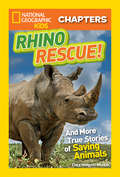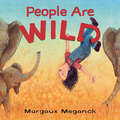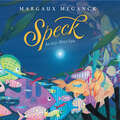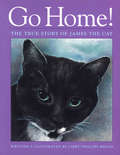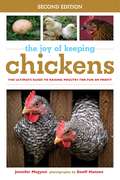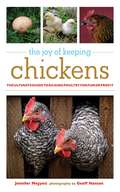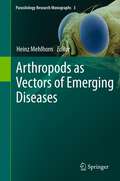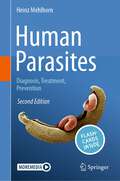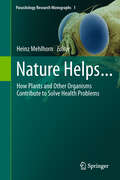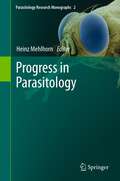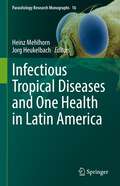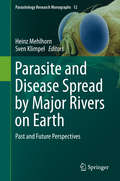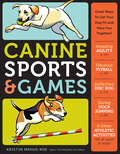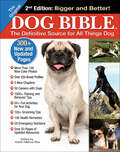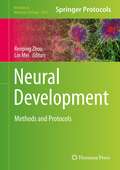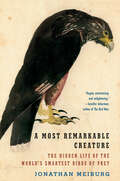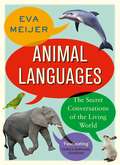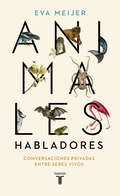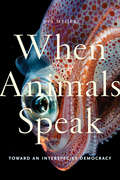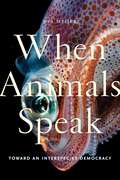- Table View
- List View
Red: A Trailing Bloodhound
by S. P. MeekDoes the New York State Police have use for a Bloodhound Platoon? Can Trooper Courtney handle Red in searching for criminal or the lost person?
Rip: A Game Protector
by S. P. MeekUpstate New York is the setting for Colonel Meek's new dog story, in which Rip, a pointer, and his master, Budge Outland, a Game Protector for the State of New York, carry out the trying job of enforcing game laws in the interests of conservation. Out-of-season hunting and illegal fur trade are their main problems, requiring of them expert detection work and keen knowledge of the outdoors. Often at the risk of their lives, the two of them live through an exciting story of a little-known, yet extremely valuable branch of public service.
Rusty: A Cocker Spaniel
by S. P. MeekWhen Ruth Hilton falls in love with him, Rusty is a tiny cocker spaniel with many physical problems. Her fiancé, a cocker spaniel expert, tries everything to make Ruth change her mind, but she must have Rusty. Who is right? An engaging and accurate portrayal of the world of cocker spaniels, including training for field trials, based on a real life champion cocker spaniel.
Surfman: The Adventures of a Coast Guard Dog
by S. P. MeekMorgan "Curly" Graham, Machinist's Mate, 2nd Class and his Chesapeake Retriever, Surfman, learn the ropes at his new assignment at the Coastguard Cape Hatteras Lifeboat Station. But Morgan has a secret hope: he wants to find out what really happened at the station more than twenty decades earlier, and clear his missing father's name. His father is officially listed as a deserter, but Curly's mother has always been certain that his father would never leave do that--and that something awful happened to Curly's father on the night he disappeared.
Rhino Rescue (National Geographic Kids Chapters)
by Clare Hodgson MeekerWhat happens when conservationists meet rhinos in trouble? They arrange to airlift them to safety! Follow National Geographic Explorers-in-Residence Dereck and Beverly Joubert as they move rhinos out of harm's way, meet a courageous little Hawaiian monk seal, and a pair of Siberian tiger cubs fighting for survival. Readers will cheer as they read these completely true stories of animal rescues. Filled with engaging photos, fast facts, and fascinating sidebars, readers won't want to put this book down.From the Hardcover Library Binding edition.
People Are Wild
by Margaux MeganckAn inviting and inventive classic-in-the-making about learning to have compassion for every living thing, gorgeously illustrated by a rising star in the picture book world.Wild creatures come in all shapes and sizes. They can be playful or loud or smelly or curious or cute—just like kids! People Are Wild turns the tables and asks what animals think of us. We may not always see eye to eye, but the more we understand each other, the better we&’re able to live in harmony. Readers who loved They All Saw a Cat or Don't Let Them Disappear will appreciate this unique perspective on the animal kingdom.
Speck: An Itty-Bitty Epic
by Margaux MeganckEverything and everyone has a place in the universe, but for a little speck, lost at sea, it will take an extraordinary journey to find it.Deep in a tide pool, too small to see,Thousands of tiny specks go forth.Each one searchingfor a place to stay, and grow, and thrive...The little speck does not know what it is, only that it wishes to find out. And so it embarks on a journey across the sea. From sun-flecked surf to darkest depths, past schools of fish, storm-tossed ships and hungry eels.... Until, at last, it finds exactly what it was looking for: a place to belong.In vivid watercolor paintings, Margaux Meganck brings this tale to life, seamlessly shifting perspective to show how even the tiniest creatures—every barnacle, every child, every star in the sky—contributes to something greater than itself.
Go Home!
by Libby Phillips MeggsJames has been lost for a long time. He's grown old and tired and slow. One day he finds a house where a kind family lives, but they decide he must belong to someone because he wears a collar. So James is left to survive a dry summer and a bad storm.
The Joy of Keeping Chickens: The Ultimate Guide to Raising Poultry for Fun or Profit (Joy of Series)
by Jennifer MegyesiFinally backyard farmers who want to keep a few hens for eggs have a bible that's attractive enough to leave out on the coffee table, and inexpensive enough to purchase on a whim. This comprehensive guide, written in charming prose from the perspective of an organic farmer, will appeal to readers who are interested in raising chickens, or simply want the best knowledge about how to cook them. With this in mind, farmer and animal expert Jennifer Megyesi discusses all the basic details of raising the birds--general biology, health, food, choosing breeds, and so on--and she cuts through the smoke to identify what terms like "organic," "free-range," and so on really mean for poultry farmers and consumers. No chicken book would be complete without information on how to show chickens for prizes, and this is no different, but The Joy of Keeping Chickens also stresses the importance of self-sustainability and organic living, and the satisfaction of keeping heirloom breeds. Readers will appreciate the comprehensive nature of this readable, informative guide, and Megyesi's enthusiasm about keeping chickens. Coupled with Geoff Hansen's gorgeous full-color photographs, this text makes for an instant classic in the category.
The Joy of Keeping Chickens
by Jennifer Megyesi Geoff HansenFinally backyard farmers who want to keep a few hens for eggs have a bible that's attractive enough to leave out on the coffee table, and inexpensive enough to purchase on a whim. This comprehensive guide, written in charming prose from the perspective of an organic farmer, will appeal to readers who are interested in raising chickens, or simply want the best knowledge about how to cook them. With this in mind, farmer and animal expert Jennifer Megyesi discusses all the basic details of raising the birds--general biology, health, food, choosing breeds, and so on--and she cuts through the smoke to identify what terms like "organic," "free-range," and so on really mean for poultry farmers and consumers.No chicken book would be complete without information on how to show chickens for prizes, and this is no different, but The Joy of Keeping Chickens also stresses the importance of self-sustainability and organic living, and the satisfaction of keeping heirloom breeds. Readers will appreciate the comprehensive nature of this readable, informative guide, and Megyesi's enthusiasm about keeping chickens. Coupled with Geoff Hansen's gorgeous full-color photographs, this text makes for an instant classic in the category.
Arthropods as Vectors of Emerging Diseases: Arthropods As Vectors Of Emerging Diseases (Parasitology Research Monographs #3)
by Heinz MehlhornGlobal warming and globalization are the buzzwords of our time. They have nearly reached a religious status and those who deny their existence are considered modern heretics. Nevertheless, the earth has become an overcrowded village, traversable within a single day. Thus it is hardly surprising that besides persons and goods also agents of disease are easily transported daily from one end of the world to the other, threatening the health and lives of billions of humans and their animals. Agents of diseases (prions, viruses, bacteria, fungi and parasites) are not only transmitted by body contact or direct exchange of bodily fluids, but also by means of vectors which belong to the groups of licking or blood-sucking arthropods (mites, ticks, insects) that live close to humans and their houses. Without a doubt the recently accelerating globalization supports the import of agents of disease into countries where they never had been or where they had long since been eradicated, leading to a false sense of living on a "safe island." These newly imported or reintroduced diseases - called "emerging diseases" - may lead to severe outbreaks in cases where the countries are not prepared to combat them, or in cases where viruses are introduced that cannot be controlled by medications or vaccines. Arthropods are well known vectors for the spread of diseases. Thus their invasion from foreign countries and their spreading close to human dwellings must be blocked everywhere (in donor and receptor countries) using safe and effective measures. This book presents reviews on examples of such arthropod-borne emerging diseases that lurk on the fringes of our crowded megacities. The following topics show that there is an ongoing invasion of potential vectors and that control measures must be used now in order to avoid disastrous outbreaks of mass diseases.
Human Parasites: Diagnosis, Treatment, Prevention
by Heinz MehlhornThe new edition of this textbook provides an up-to-date overview of the most important parasites in humans and their potential vectors. Climate change and globalization steadily favor the opportunities for parasites to thrive. These challenges call for the latest information on pathogen transmission routes and timely preventive measures.For each parasite, this book offers a concise summary in eleven sections:1. Naming2. Geographic distribution and epidemiology3. Morphology, biology and life cycle4. Disease symptoms5. Diagnosis6. Infection pathways7. Prophylaxis8. Incubation period9. Prepatency10. Patency11. Therapeutic optionsNumerous tables, diagrams and over 200 colorful illustrations highlight the main aspects of parasitic infestations and present suitable control measures. Moreover, 60 questions help to test readers’ theoretical knowledge of the field. Readers can additionally download the free Springer Nature Flashcards App and benefit from the digital study questions.In short, this work is highly recommended for anyone looking to delve into the field of human parasitology. It is intended for students of biology and human medicine, medical doctors, pharmacists and laboratory staff alike. Furthermore, persons who plan to visit or live longer in endemic regions will find essential information on necessary preventive and control measurements.
Nature Helps...
by Heinz MehlhornNature helps... of course at first itself by developing measures that give bacteria, fungi, plants and animals a chance to be successful in their struggle for life. As a latecomer on Earth, Homo sapiens was gifted with some droplets of the divine spirit of recognition and thus became able to observe, to analyse and recombine skills of other living beings and to use them for his overwhelming career over the last 10,000 years. Of course fungi, plants, animals and even bacteria were primarily used by mankind as food or as lifestyle products such as beer, but soon it became clear that there was much more potential hidden in these organisms and that they could be used for other purposes, too. Extracts of plants and fungi were recognized as powerful remedies, as medicines, as insecticides or acarizides, as repellents against parasites or even as weapons, e.g. when poisonous compounds from frogs or plants were applied to arrowheads. Over the last 110 years the pharmaceutical industry has often simulated nature by analyzing complex organic substances taken from living organisms and then producing by synthesis absolutely pure compounds, which mostly consisted of only one single active substance. These products had the advantage of acting against precisely one target and thus produced fewer possible side effects than the complex plant extracts. However, the more serious side effect was that disease agents could develop resistances to pure medicinal products much more easily. Thus after 70 years of excellent prospects for chemotherapy, some dark clouds appeared and quickly gathered, so that several therapeutic remedies now no longer work. Therefore in many countries - especially in those where the pure chemotherapeutics are too expensive for the poor population - the cry "back to nature" is becoming louder and louder. This has led to an enormous increase of studies that again use natural extracts as remedies in the fight against diseases. The present book summarizes examples of promising aspects in a broad spectrum of applications and shows how extracts derived from bacteria, marine organisms, plants or even animals may help to treat infectious diseases, how such organisms may keep away parasites and pests from the bodies of plants or animals, including humans, and how they can be used directly to aid in diagnosis, promote wound healing and even to help catch criminals. These 15 chapters offer not only basic research on these different fields, but also show how useful and effective products can be developed from research.
Progress in Parasitology
by Heinz MehlhornParasites threaten the health of animals and humans alike. Especially in times of increasing globalization and global warming, parasites can enlarge their "kingdom" by spreading. At the same time many of the existing medical products have become ineffective. As these products have been used for many decades, parasites have developed resistances, so that they have progressed in their fight for survival. Therefore it is obvious that humans must develop new methods to face these dangers. Thus parasitological knowledge increases daily and must be formulated to be accessible for as many parasitologists (veterinarians, physicians, biologists) as possible. Therefore it is necessary that reviews reflecting the present status of the progress in many fields of research be published. Therefore this book, published on the occasion of the 50th anniversary of the German Society of Parasitology, compiles 18 reviews on recent "hot topics," including a new vaccine against malarial parasites; severe diseases with poor chances of treatment (cryptosporidiosis, coccidiosis, theileriosis); vectors (mosquitoes, ticks) and their transmission activities; and fish parasites, including molecular insights into the sex of parasites with a focus on the survival abilities that made them so dangerous. These chapters provide detailed information for researchers, as well as for teachers and students in parasitology.
Infectious Tropical Diseases and One Health in Latin America (Parasitology Research Monographs #16)
by Heinz Mehlhorn Jorg HeukelbachThis book covers current aspects of important infectious diseases affecting human and animal health in Latin American countries. Readers are equipped with details on arthropod vectors as well as on neglected health problems. Diseases covered include Neglected Tropical Diseases such as Chagas Disease, schistosomiasis, tungiasis, myiasis and leishmaniasis, but also Zika and Chikungunya viral infections, plague and yellow fever. One focus is given on parasitic transmission routes.In addition, the authors describe current therapeutic options and sustainable control measures, considering both human and animal health. By highlighting options within the interdisciplinary One Health approach, they round off this work into a cutting-edge reference for diverse expert readers. Scientists and clinicians concerned on public health, entomology, tropical medicine and parasitology not only in Latin America will find this collection particularly valuable.Finally, these contributions are essential in the framework of the Sustainable Development Goals and the targets of SDG 3 (Good Health and Well-being) in order to combat and end epidemics of Neglected Tropical Diseases.
Parasite and Disease Spread by Major Rivers on Earth: Past and Future Perspectives (Parasitology Research Monographs #12)
by Heinz Mehlhorn Sven KlimpelThis book focuses on waterborne pathogens and significant diseases occurring along major rivers around the globe, including key examples like the Amazonas, Mekong River and Nile. Written by leading international experts, it offers unique insights into local riverine infection risks in times of global warming, and addressing these through advances in diagnosis, health management and the development of simple but effective control measures. It also sheds light on why former societies collapsed due to transmitted diseases during periods of climate change, droughts and floods, to help establish effective preventive measures for the future. The book appeals to a wide readership, from scientists in the field of parasitology, infectious diseases and epidemiology, to healthcare managers and general readers with an interest in pathogen spread along the largest rivers on earth. It particularly highlights past and current control mechanisms in times of global warming and assesses potential future health hazards.
Canine Sports & Games: Great Ways to Get Your Dog Fit and Have Fun Together!
by Kristin Mehus-RoeGet your dog off the leash and in on the game. Organized games are a wonderful way to bond with your pet while giving him the mental stimulation and physical exercise he needs. <P><P>Kristin Mehus-Roe has games for all types of dog personalities and abilities, complete with rules, equipment lists, safety reminders, and much more. Teach your energetic pooch how to play flyball and your water-loving retriever to enjoy an afternoon of dock jumping. You and your dog have never had so much fun!
The Original Dog Bible: The Definitive Source for All Things Dog
by Kristin Mehus-RoeThe wooftasticsecond edition. &“This attractive, copiously illustrated easy-to-understand volume covers every aspect of responsible dog ownership.&” —Library Journal The revised and expanded second edition of the bestselling The Original Dog Bible remains the most comprehensive dog lover&’s resource on the market! The book is divided into eight parts—each fully illustrated and designed for easy reference—plus helpful, entertaining sidebars covering hundreds of related topics. With detailed chapters on the requirements of caring for a dog, health, training, and so much more, this book will prepare you for a wonderful life with a dog. Also included is a catalog of over 250 purebred dog breeds with insightful articles for each!&“Being a veteran veterinarian of twenty five years and a lifetime pet lover, I can enthusiastically say &‘this old doc learned new tricks&’ upon reading the consummate book on all things dogs . . . I highly recommend it!&” —Dr. Marty Becker, former resident veterinarian on ABC&’s Good Morning America and coauthor of Chicken Soup for the Dog Lover&’s Soul&“This comprehensive book certainly lives up to its subtitle . . . The best part of the book, however, covers &‘life with a dog,&’ with sections on pet care partners like sitters and walkers, emergencies, lost dogs, biting, traveling with a dog, and a fantastic chapter on activities one can do with one&’s dog.&” —Publishers Weekly
Neural Development
by Lin Mei Renping ZhouUnderstanding the molecular and cellular mechanisms underlying the development of specific neural circuits is not just an intellectual curiosity but also central to our ability to develop therapeutic approaches to repair damaged pathways in the future. In Neural Development: Methods and Protocols, experts in the field contribute commonly used protocols to facilitate future research in developmental neuroscience. Split into four convenient sections, this detailed volume covers techniques of culturing neurons and glia as well as their growth and differentiation, methods of gene delivery and down regulation, protocols for analyzing axon growth and guidance plus synapse formation, and, finally, basic methods to analyze brain morphology and axon pathways in developing animals. Written in the highly successful Methods in Molecular Biology series format, chapters include introductions to their respective topics, lists of the necessary materials and reagents, step-by-step, readily reproducible laboratory protocols, and tips on troubleshooting and avoiding known pitfalls. Comprehensive and accessible, Neural Development: Methods and Protocols provides key guidance for students and postdoctoral fellows new to developmental neurobiology.
A Most Remarkable Creature: The Hidden Life and Epic Journey of the World's Smartest Birds of Prey
by Jonathan Meiburg&“A fascinating, entertaining, and totally engrossing story.&”—David Sibley, author of What It's Like to Be a Bird &“Utterly captivating and beautifully written, this book is a hugely entertaining and enlightening exploration of a bird so wickedly smart, curious, and social, it boggles the mind.&”—Jennifer Ackerman, author of The Bird Way &“As curious, wide-ranging, gregarious, and intelligent as its subject.&”—Charles C. Mann, author of 1491 An enthralling account of a modern voyage of discovery as we meet the clever, social birds of prey called caracaras, which puzzled Darwin, fascinate modern-day falconers, and carry secrets of our planet's deep past in their family history.In 1833, Charles Darwin was astonished by an animal he met in the Falkland Islands: handsome, social, and oddly crow-like falcons that were "tame and inquisitive . . . quarrelsome and passionate," and so insatiably curious that they stole hats, compasses, and other valuables from the crew of the Beagle. Darwin wondered why these birds were confined to remote islands at the tip of South America, sensing a larger story, but he set this mystery aside and never returned to it. Almost two hundred years later, Jonathan Meiburg takes up this chase. He takes us through South America, from the fog-bound coasts of Tierra del Fuego to the tropical forests of Guyana, in search of these birds: striated caracaras, which still exist, though they're very rare. He reveals the wild, fascinating story of their history, origins, and possible futures. And along the way, he draws us into the life and work of William Henry Hudson, the Victorian writer and naturalist who championed caracaras as an unsung wonder of the natural world, and to falconry parks in the English countryside, where captive caracaras perform incredible feats of memory and problem-solving. A Most Remarkable Creature is a hybrid of science writing, travelogue, and biography, as generous and accessible as it is sophisticated, and absolutely riveting.
Animal Languages: The secret conversations of the living world
by Eva Meijer'A rich compendium of incidents, anecdotes and studies illustrating the linguistic abilities of animals . . . a rewarding book' Sunday TimesDolphins and parrots call each other by their names. Fork tailed drongos mimic the calls of other animals to scare them away and then steal their dinner. In the songs of many species of birds, and in skin patterns of squid, we find grammatical structures . . .If you are lucky, you might meet an animal that wants to talk to you. If you are even luckier, you might meet an animal that takes the time and effort to get to know you. Such relationships can teach us not only about the animal in question, but also about language and about ourselves.From how prairie dogs describe intruders in detail -- including their size, shape, speed and the colour of their hair and T-shirts -- to how bats like to gossip, to the impressive greeting rituals of monogamous seabirds, Animal Languages is a fascinating and philosophical exploration of the ways animals communicate with each other, and with us. Researchers are discovering that animals have rich and complex languages with grammatical and structural rules that allow them to strategise, share advice, give warnings, show love and gossip amongst themselves. Animal Languages will reveal this surprising hidden social life and show you how to talk with the animals.
Animales habladores: Conversaciones privadas entre seres vivos
by Eva MeijerLos animales hablan. Claro que hablan. El problema es que no los escuchamos. «Un libro fascinante y accesible sobre cómose comunican los animales».The Guardian Los delfines y los loros se llaman entre sí por su nombre; los perros de las praderas describen a los intrusos con todo lujo de detalles - incluidos su tamaño, forma, velocidad y el color de su cabello o de sus camisetas-; a los murciélagos les encanta chismear; en los cantos de algunos pájaros y en los patrones de la piel de los calamares encontramos estructuras gramaticales... Con un poco de suerte, algún día se toparán con un animal que quiera hablar con ustedes, o incluso que se tome el tiempo y el esfuerzo de conocerlos. Si eso ocurre, comprobarán lo mucho que este tipo de relaciones nos enseñan sobre el lenguaje y sobre nosotros mismos. Cada vez son más los hallazgos científicos que demuestran que los animales tienen lenguajes ricos y complejos con reglas estructurales que les permiten diseñar estrategias, dar consejos, mostrarse amor e incluso cotillear. Animales habladores es una fascinante exploración filosófica (en compañía de autores como Aristóteles, Descartes, Wittgenstein y Heidegger) de las formas en que los animales se comunican entre sí y con nosotros, que revela su vida social secreta y sorprendente, cuestiona la jerarquía entre los humanos y el resto de criaturas y propone una nueva forma de entender el lenguaje. La crítica ha dicho:«Un puñado de historias fascinantes y mucho que aprender de ellas... Meijer demuestra que muchos animales son más sofisticados y más inteligentes de lo que creemos».The Spectator «Eva Meijer se ha propuesto redefinir la relación entre humanos y animales. Una visión audaz y progresista de un futuro más justo en el que la humanidad mejora al compartir la Tierra simplemente aprendiendo a escuchar».The Herald Tribune «Fascinante».Daily Mail «Rebosante de anécdotas fabulosamente entretenidas».Strong Words
When Animals Speak: Toward an Interspecies Democracy (Animals in Context #1)
by Eva MeijerA groundbreaking argument for the political rights of animals In When Animals Speak, Eva Meijer develops a new, ground-breaking theory of language and politics, arguing that non-human animals speak—and, most importantly, act—politically. From geese and squid to worms and dogs, she highlights the importance of listening to animal voices, introducing ways to help us bridge the divide between the human and non-human world. Drawing on insights from science, philosophy, and politics, Meijer provides fascinating, real-world examples of animal communities who use their voices to speak, and act, in political ways. When Animals Speak encourages us to rethink our relations with other animals, showing that their voices should be taken into account as the starting point for a new interspecies democracy.
When Animals Speak: Toward an Interspecies Democracy (Animals in Context #1)
by Eva MeijerA groundbreaking argument for the political rights of animals In When Animals Speak, Eva Meijer develops a new, ground-breaking theory of language and politics, arguing that non-human animals speak—and, most importantly, act—politically. From geese and squid to worms and dogs, she highlights the importance of listening to animal voices, introducing ways to help us bridge the divide between the human and non-human world. Drawing on insights from science, philosophy, and politics, Meijer provides fascinating, real-world examples of animal communities who use their voices to speak, and act, in political ways. When Animals Speak encourages us to rethink our relations with other animals, showing that their voices should be taken into account as the starting point for a new interspecies democracy.

